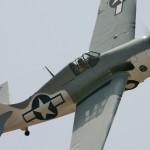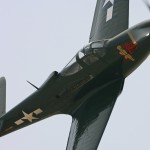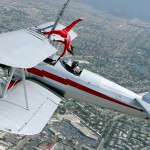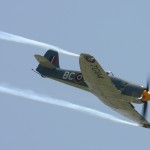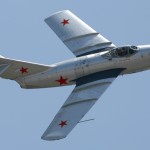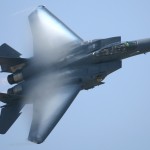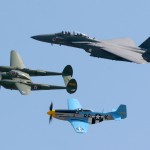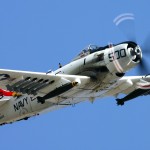By Victor G. Archer
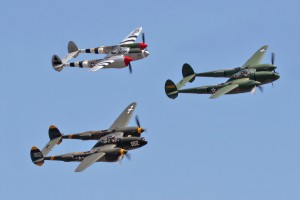
“Lightning Strikes!” the P-38 Lightning formation flight, included Steve Hinton in Glacier Girl, followed by Kevin Eldridge in 23 Skidoo and Jeff Harris flying a silver Lightning.
On May 19-20, the Air Museum Planes of Fame hosted its 51st annual air show. The museum always puts together something unique for each show. This year’s feature, “Lightning Strikes!” was a special and unusual sight. Now rare, the Lockheed P-38 Lightning was one of the most famous fighter planes of World War II; thanks to the museum, guests were able to see three P-38 Lightnings flying together in formation.
The show started with a Grumman Ironworks Flight, featuring an F3F Flying Barrel, FM2 Wildcat, F6F Hellcat, F7F Tigercat, F8F Bearcat and TBM Avenger. This represented more than 15 years of naval aircraft developed by the Grumman Aircraft Company. Next up was a classic wing-walking performance from Silver Wings, featuring pilot Hartley Folstad, wing walker Margi Stivers and their Stearman biplane. Stivers thrilled the spectators with some of her more unique poses, like the handstand and bending backwards off the top wing, reaching back to the cockpit below. It was interesting to note that at the show’s 51st anniversary, Stivers performed her 1,050th and 1,051st wing walks.
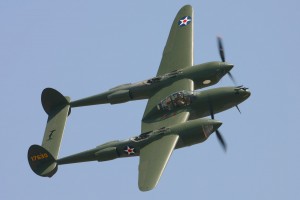
Steve Hinton gives the crowd a close look at Glacier Girl, one of only five remaining P-38Fs and the only one that’s airworthy.
The museum brought out a big group of WWII warbirds for the Pacific Air Battle display. Aircraft that flew in this group included a Hawker Hurricane, Supermarine Spitfire, Grumman Wildcat and Hellcat, Douglas Dauntless, Chance Vought F4U Corsair, two Japanese Mitsubishi Zeros, Japanese Aichi Val, Curtiss P-40 Warhawk, Bell P-63 King Cobra, Lockheed P-38 Lightning and North American P-51 Mustang. First, the Japanese aircraft, the Val dive-bomber, escorted by the two Zeros, made a run on the field. Then the Zeros departed to fly top cover and got into a dogfight with the Hurricane and the Spitfire. The remaining Allied aircraft chased off the Japanese Val and made several low-level passes in front of the crowd line. Rob Harrison, the “Tumbling Bear,” followed the air war with a dynamic aerobatic routine in his Zlin 50.
During a short break from the flying, a military ground combat demonstration included a Sherman tank and several other armored vehicles. The next group of aircraft to fly represented the Korean Air War, with aircraft such as the Stinson L-5 Sentinel, North American T-6 Texans and F-51 Mustangs, Chance Vought F4U Corsair and a British-built Hawker Sea Fury. Also flying in this group were some of the early jet aircraft, including a Lockheed T-33 Shooting Star, North American F-86 Sabre and Russian MiG-15. Most of the fighter aircraft made several low level passes, while the F-86 Sabre and the MiG-15 put on a great tail-chase routine across the sky.
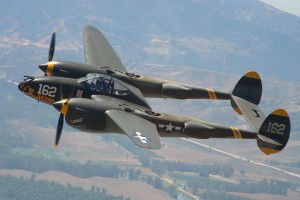
John Maloney flew 23 Skidoo, the Planes of Fame’s P-38 Lightning. It’s one of only six remaining J model P-38s.
The U.S. Navy tactical demonstration team showcased its F-18 Super Hornets, followed by a Navy Legacy Flight, with the F-18 and an F8F Bearcat flying together in formation. The next flying demonstration, Brian Sanders’ Sea Fury aerobatic routine, was a real treat for the crowd. With smoke generators on the wingtips, Sanders put the Sea Fury through an amazing performance. It’s more like watching a military-style tactical demonstration than aerobatics.
Next was the mass air power formation flight—something only seen at Chino’s air show. Aircraft in this year’s group included three P-38s, four P-51s, two P-47s, two P-40s, two F6Fs, four B-25s, a Spitfire, a Hurricane and a B-17. This special formation usually has more than 30 planes flying at one time and is truly an amazing sight.
For the “Lightning Strikes!” demonstration, three Lockheed P-38 Lightnings went up together. Steve Hinton led the way in Glacier Girl, followed by Kevin Eldridge in 23 Skidoo and Jeff Harris flying a silver Lightning. All three made several close passes, and then Hinton broke off to perform aerobatic maneuvers.

Less than 20 P-38L Lightnings remain. Jeff Harris is at the controls of this silver Lightning adorned with D-Day invasion stripes.
The Air Force F-15 Strike Eagle tactical demonstration team of Capt. Al Kennedy and Capt. Jack Stallworth took to the sky with high-speed maneuvers, including a knife-edge pass, high G turns and mock ground attacks. The F-15 Strike Eagle is a dual-role fighter, designed to perform air-to-air and air-to-ground missions at low altitude, day or night, and in all weather. After the demonstration, a P-51 Mustang, flown by Chuck Hall, and Glacier Girl, flown by Hinton, joined in for the USAF Heritage Flight.
The next air war campaign demonstrated aircraft of the Vietnam War. Aircraft in this group included the Douglas AD-6 Skyraider, O-1 Bird Dogs, a T-28 Trojan and a Huey helicopter. This demonstration was the final act of another amazing air show from the museum.
Several more aircraft, military vehicles and other aviation-related items were on display for guests to inspect up close. The truly adventurous had opportunities to experience the thrill of orientation flights in genuine warbirds, such as the P-51 Mustang and P-40 Warhawk. A great variety of food, beverage and memorabilia vendors were also available to help make the experience even more enjoyable.
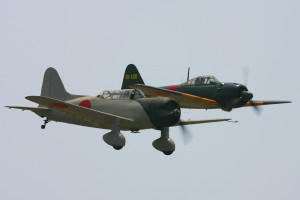
Escorted by a Mitsubishi A6M5 Zero flown by John Maloney, an Aichi Val dive-bomber (originally a BT-13) flown by John Hinton makes a mock bombing run on the field. The Val has been in several movies, including “Pearl Harbor.”
Planes of Fame was the first permanent air museum in the American West, and is a pioneer in restoring aircraft to flying condition. Donations and admission fees provide most of the operating funds for the museum, staffed by a core of dedicated volunteers. The museum has a special membership program available, with one benefit being the opportunity to experience flights in genuine warbirds.
For more information about the Air Museum Planes of Fame, call 909-597-3722 or visit [http://www.planesoffame.org].
- Thomas Camp owns and pilots this General Motors-built Grumman FM2 Wildcat. This nicely restored aircraft travels to Nevada every September to take part in the air races in Reno.
- Another rare aircraft flying was this beautifully restored Bell P-63 King Cobra, piloted by John Dale. With less than 20 King Cobras remaining today, this is one of only four or five in airworthy condition.
- Another aircraft from the movies, this beautifully restored Goodyear-built FG-1D Corsair flew in the TV Series “Black Sheep Squadron.” In 2003, this Corsair was selected as EAA Oshkosh AirVenture’s Grand Champion Warbird in the World War II division.
- Pilot Hartley Folstad and wing walker Margi Stivers of the Silver Wings wing-walking team performed at the air show. Stivers thrilled spectators with some of her more unique poses, like bending backward off the top wing, while reaching to the cockpit.
- Brian Sanders, piloting the British-built Hawker Sea Fury Argonaut, put on a high-performance demonstration for the crowd. With a top speed of 400 mph, Argonaut also sees action as a Reno air racer.
- A Russian-built Mig-15, piloted by Chris Fahey, flew in the Korean Air War demonstration.
- Steve Hinton flew the Planes of Fame’s North American F-86 Sabre. The F-86 entered service with the Air Force in 1949 and became the primary air-to-air jet fighter used in the Korean War.
- The USAF F-15 Strike Eagle tactical demonstration team of Capt. Al Kennedy and Capt. Jack Stallworth makes a high-speed dedication pass.
- Steve Hinton led the USAF Heritage Flight in the P-38 Glacier Girl, followed by Chuck Hall in his P-51 Mustang Six Shooter (bottom) and Capt. Al Kennedy in the USAF F-15E Strike Eagle.
- Bob Grondzik, better known as “Skyraider Bob,” gives attendees a good look at this 1955 Douglas AD-6 Skyraider.












